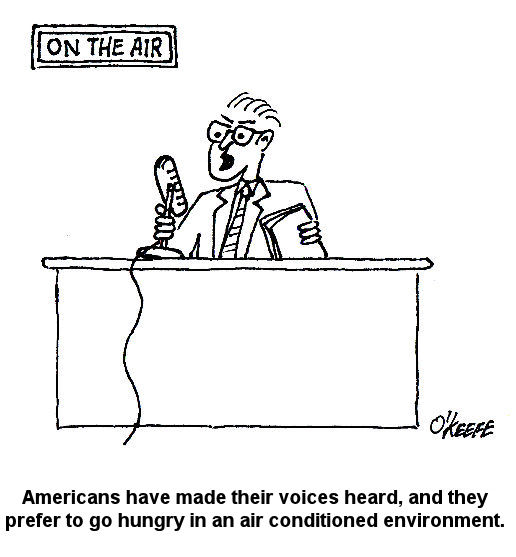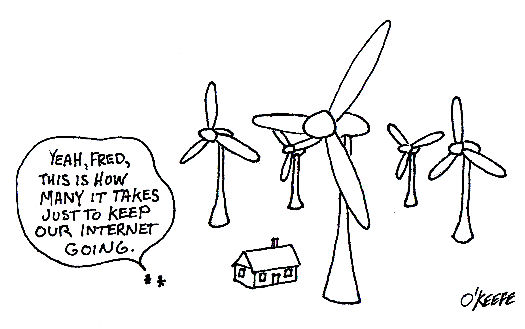|
The last few weeks we’ve been discussing some of the technical and environmental drawbacks of alternative sources of electrical energy and nuclear power generation. This week we’ll take a look at another drawback, that of energy sprawl.
So what exactly is “energy sprawl?” It’s an easily understand concept, but one that is often overlooked by proponents of the alternative energy movement. Energy sprawl is simply the amount of land which is taken over by alternative power sources in order to generate a given amount of electricity, and that number is dauntingly large.
For example, let’s revisit the subject of wind turbines. According to the National Renewable Energy Laboratory (NREL) of the U.S. Department of Energy, each turbine is to be spaced five to ten turbine diameters apart in a wind farm, depending on local conditions. Now the blades of a 2 megawatt (2 million watt) wind turbine are about 260 feet in diameter, and for our example we’ll space them at the prescribed minimum distance of five diameters. The math for this one is easy, 260 times five, which equates to spacing of 1333 feet, or just over a quarter of a mile. That’s right, if you build a wind turbine farm with a whole bunch of these 2 megawatt turbines, they’ll have to be spaced a minimum of a quarter mile apart. You’ll need a lot of acreage.
So based on the calculations above, we’d have to build a wind farm where each 2 megawatt turbine is surrounded by a circle of empty land 1333 feet in radius. We know from geometry that the area of a circle can be calculated by multiplying pi, that is 3.1416, times its radius squared, and this translates into a minimum area of about 5.6 million square feet per 2 megawatts of power generated, or about 2.8 million square feet per megawatt. Just to put this into perspective, a football field has an area of 57,564 square feet. So what we’re actually talking about here is a little more than 48 football fields worth of land per megawatt of electricity generated!
Let’s turn our attention now to solar power generation. We want to generate electricity with their photo-voltaic (PV) panels, and these panels are made of special materials that convert the sun’s energy directly into electricity. Great concept, but here again we’re talking a lot of land. According to the NREL, it’s estimated that 6.4 acres are required to generate 1 megawatt of electricity using PV panels. Since one acre equals 43,560 square feet, we’d need a total of 278,784 square feet of land area per megawatt. After we’ve done the math we discover that this equates to almost five football fields of area per megawatt of electricity generated.
We’ve now established that loads of land space is required to operate multiple options for alternative energy, and you’re probably wondering how this all compares to land usage for fossil fuel (i.e. coal, oil, natural gas) and nuclear power generation. Well, a typical 1000 megawatt coal fired power plant occupies about 148 million square feet. This translates to around 148,000 square feet per megawatt, which is just over two and a half football fields per megawatt. As for a 1000 megawatt nuclear power plant, we’re talking about 28 million square feet that’s typically occupied by an operating plant, and that translates to almost 28,000 square feet per megawatt, or a little less than half of a football field per megawatt.
Math established, it’s a hands down victory for fossil fuel and nuclear plants compared to wind turbine and solar energies when it comes to land usage. Last time I checked tillable land acreage was going down, not up, around cities where electricity demand is highest. Do we start pushing farther outward to build wind turbine and PV farms on vast expanses of land currently occupied by forests or used to grow our food? Which would you rather do, eat or have electricity?
_____________________________________________
|
Posts Tagged ‘alternative energy’
Alternative Energy Sprawl
Sunday, May 2nd, 2010Another Opinion About Alternative Energy
Sunday, April 25th, 2010|
This week we’re continuing our discussion on alternative energy by introducing another voice. A couple of articles ago you were urged to seek a second opinion on the realities of alternative energy. The following article in the Washington Post by Robert Bryce will constitute another attempt to get a full understanding of the picture. Consider it your third professional opinion on the matter…
Five myths about green energy
By Robert Bryce Americans are being inundated with claims about renewable and alternative energy. Advocates for these technologies say that if we jettison fossil fuels, we’ll breathe easier, stop global warming and revolutionize our economy. Yes, “green” energy has great emotional and political appeal. But before we wrap all our hopes — and subsidies — in it, let’s take a hard look at some common misconceptions about what “green” means. 1. Solar and wind power are the greenest of them all. Unfortunately, solar and wind technologies require huge amounts of land to deliver relatively small amounts of energy, disrupting natural habitats. Even an aging natural gas well producing 60,000 cubic feet per day generates more than 20 times the watts per square meter of a wind turbine. A nuclear power plant cranks out about 56 watts per square meter, eight times as much as is derived from solar photovoltaic installations. The real estate that wind and solar energy demand led the Nature Conservancy to issue a report last year critical of “energy sprawl,” including tens of thousands of miles of high-voltage transmission lines needed to carry electricity from wind and solar installations to distant cities. Nor does wind energy substantially reduce CO2 emissions. Since the wind doesn’t always blow, utilities must use gas- or coal-fired generators to offset wind’s unreliability. The result is minimal — or no — carbon dioxide reduction. Denmark, the poster child for wind energy boosters, more than doubled its production of wind energy between 1999 and 2007. Yet data from Energinet.dk, the operator of Denmark’s natural gas and electricity grids, show that carbon dioxide emissions from electricity generation in 2007 were at about the same level as they were back in 1990, before the country began its frenzied construction of turbines. Denmark has done a good job of keeping its overall carbon dioxide emissions flat, but that is in large part because of near-zero population growth and exorbitant energy taxes, not wind energy. And through 2017, the Danes foresee no decrease in carbon dioxide emissions from electricity generation. 2. Going green will reduce our dependence on imports from unsavory regimes. In the new green economy, batteries are not included. Neither are many of the “rare earth” elements that are essential ingredients in most alternative energy technologies. Instead of relying on the diversity of the global oil market — about 20 countries each produce at least 1 million barrels of crude per day — the United States will be increasingly reliant on just one supplier, China, for elements known as lanthanides. Lanthanum, neodymium, dysprosium and other rare earth elements are used in products from high-capacity batteries and hybrid-electric vehicles to wind turbines and oil refinery catalysts. China controls between 95 and 100 percent of the global market in these elements. And the Chinese government is reducing its exports of lanthanides to ensure an adequate supply for its domestic manufacturers. Politicians love to demonize oil-exporting countries such as Saudi Arabia and Iran, but adopting the technologies needed to drastically cut U.S. oil consumption will dramatically increase America’s dependence on China. 3. A green American economy will create green American jobs. In a global market, American wind turbine manufacturers face the same problem as American shoe manufacturers: high domestic labor costs. If U.S. companies want to make turbines, they will have to compete with China, which not only controls the market for neodymium, a critical ingredient in turbine magnets, but has access to very cheap employees. The Chinese have also signaled their willingness to lose money on solar panels in order to gain market share. China’s share of the world’s solar module business has grown from about 7 percent in 2005 to about 25 percent in 2009. Meanwhile, the very concept of a green job is not well defined. Is a job still green if it’s created not by the market, but by subsidy or mandate? Consider the claims being made by the subsidy-dependent corn ethanol industry. Growth Energy, an industry lobby group, says increasing the percentage of ethanol blended into the U.S. gasoline supply would create 136,000 jobs. But an analysis by the Environmental Working Group found that no more than 27,000 jobs would be created, and each one could cost taxpayers as much as $446,000 per year. Sure, the government can create more green jobs. But at what cost? 4. Electric cars will substantially reduce demand for oil. Nissan and Tesla are just two of the manufacturers that are increasing production of all-electric cars. But in the electric car’s century-long history, failure tailgates failure. In 1911, the New York Times declared that the electric car “has long been recognized as the ideal” because it “is cleaner and quieter” and “much more economical” than its gasoline-fueled cousins. But the same unreliability of electric car batteries that flummoxed Thomas Edison persists today. Those who believe that Detroit unplugged the electric car are mistaken. Electric cars haven’t been sidelined by a cabal to sell internal combustion engines or a lack of political will, but by physics and math. Gasoline contains about 80 times as much energy, by weight, as the best lithium-ion battery. Sure, the electric motor is more efficient than the internal combustion engine, but can we depend on batteries that are notoriously finicky, short-lived and take hours to recharge? Speaking of recharging, last June, the Government Accountability Office reported that about 40 percent of consumers do not have access to an outlet near their vehicle at home. The electric car is the next big thing — and it always will be. 5. The United States lags behind other rich countries in going green. Over the past three decades, the United States has improved its energy efficiency as much as or more than other developed countries. According to data from the Energy Information Administration, average per capita energy consumption in the United States fell by 2.5 percent from 1980 through 2006. That reduction was greater than in any other developed country except Switzerland and Denmark, and the United States achieved it without participating in the Kyoto Protocol or creating an emissions trading system like the one employed in Europe. EIA data also show that the United States has been among the best at reducing the amount of carbon dioxide emitted per $1 of GDP and the amount of energy consumed per $1 of GDP. America’s move toward a more service-based economy that is less dependent on heavy industry and manufacturing is driving this improvement. In addition, the proliferation of computer chips in everything from automobiles to programmable thermostats is wringing more useful work out of each unit of energy consumed. The United States will continue going green by simply allowing engineers and entrepreneurs to do what they do best: make products that are faster, cheaper and more efficient than the ones they made the year before. Robert Bryce is a senior fellow at the Manhattan Institute. His fourth book, “Power Hungry: The Myths of ‘Green’ Energy and the Real Fuels of the Future,” will be out Tuesday, April 27. To visit the Washington Post article above go to: http://www.washingtonpost.com/wp-dyn/content/article/2010/04/23/AR2010042302220.html _____________________________________________ |
Nuclear Power, Is It The Answer?
Sunday, April 18th, 2010|
In weeks past we’ve explored wind energy and the possibility of it overtaking fossil fuel burning plants as our main source of power. This week we’ll discuss the next most viable option to do the job, that of nuclear power. Nuclear power, unlike fossil fuel plants, doesn’t combust fuel and therefore doesn’t contribute to air pollution. But unlike wind turbines, their electrical output is reliable, that is to say, we know, save for a major breakdown, that they will put out X-amount of power every day, regardless of weather conditions. As a matter of fact, according to the Nuclear Energy Institute, the 103 nuclear power plants in operation in the United States today are the most reliable and efficient producers of energy to our electric power grid. They account for about 20% of the power generated and produce a total capacity of 96.245 gigawatts, meaning, a whopping 96.245 billion watts. Nuclear energy is clean, reliable, and produces loads of power, so why not initiate a program to begin immediate replacement of our dirty fossil fueled plants? It’s time to take a closer look. Needless to say, large scale replacement of fossil fueled power plants with nuclear power plants would be a huge undertaking. You’ll remember from my previous blog postings that the US Department of Energy reports that 71.2% of our power is currently being produced by burning fossil fuels. All power plants, and especially nuclear power plants, are extremely expensive to build. Let’s look at an example. In 2007, Florida Power & Light informed the Florida Public Service Commission that the cost to build a new nuclear plant in south Florida would be approximately $8,000 per kilowatt-hour. How does this large sum affect the consumer in terms of real dollars? Well, let’s say you want to build a 3,000 megawatt (3,000 million watt) nuclear plant. This is enough capacity to provide power for about 2 million people in the US. When all is said and done, you’ll end up having to pay out $24 billion before you can start generating electricity. That looks like a lot of cash outlay for one plant, but what does it mean to each individual? If we do the math, a nuclear plant that is capable of supplying 2 million people with electricity will result in a cost of approximately $12,000 per person. Considering that, will investors, taxpayers, and consumers be willing to cover the losses that accrue when all existing fossil plants are closed and nuclear plants are erected to replace them? As with wind powered energy, cost is an enormous factor when considering the viability of nuclear power plants, but there is something way more profound to consider. Nuclear power plants produce radioactive waste. This waste remains radioactive, and therefore highly poisonous to the environment, for millions of years. That’s right, millions, not hundreds, not thousands, millions of years. The Nuclear Energy Information Service states that for each nuclear reactor that exists, 50 to 60 tons of high level radioactive waste is produced every year. So you’ve got all this waste as a byproduct of nuclear energy production, and, of course, there’s a lot of controversy surrounding its safe disposal. Not only does it lay around for millions of years, the costs of dealing with it are staggering. The US Department of Energy estimated in 2008 that it will cost around $96 billion to construct the Yucca Mountain nuclear waste repository in Nevada, which is basically a huge underground garbage dump for nuclear waste. And this amount of money will only keep it in operation for about 150 years. What happens after that? And if we build more nuclear plants in addition to those that currently exist, what will then be the cost of disposing of their waste? No one knows for sure, but they know it’s a mighty large sum, and certainly much too large for the ailing American economy to absorb. Now, Dr. Seuss, the guy that wrote The Cat in the Hat and other wonders, was an actual person, and he had a lot to say about things that didn’t involve gnarly looking creatures that go “BUMP!” in the night: “Sometimes the questions are complicated and the answers are simple.” Well, that’s sort of the case here. There are a lot of seemingly simple answers being posed to address our energy and environmental problems, but when you start asking pointed questions to delve deeply into the feasibility of those answers, things can get extremely complicated. We have seen through our present blog series that these answers inevitably lead to more questions and a multiplicity of other problems, and so far we haven’t seen an easy fix to our energy issues. But are we just making an issue where none exists? Are we making a mountain out of a mole hill? Next week we’ll explore a few more options that are being considered as alternative energy sources. Perhaps there is an easy answer to our power dilemma. _____________________________________________ |






